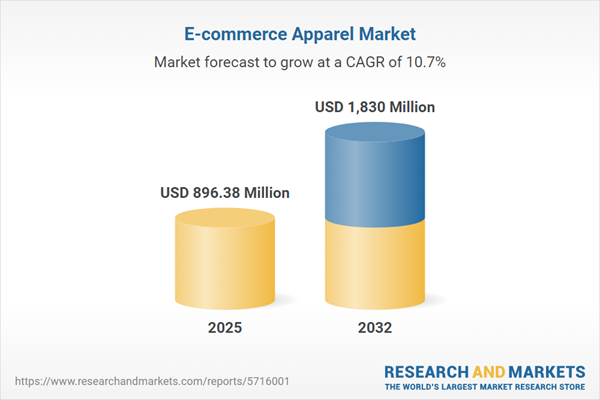Speak directly to the analyst to clarify any post sales queries you may have.
The e-commerce apparel market is undergoing rapid transformation as digital innovation, shifting consumer expectations, and integrated omnichannel strategies lead brands and retailers to reimagine their operations and competitiveness. Senior decision-makers must focus on adaptability, sustainability, and technological advancement to maintain profitable growth and resilience.
Market Snapshot: Key Growth Drivers in the E-commerce Apparel Market
As digital transformation accelerates across fashion, the e-commerce apparel market records robust growth driven by increased online and mobile shopping. Enhanced digital experiences now increase brand engagement, connecting businesses with both end-users and B2B partners through more personalized and efficient communication. Companies deploying integrated omnichannel platforms can track changing demand quickly, leveraging advanced analytics for targeted outreach. Those investing in digital infrastructure and cultivating a culture of innovation are better positioned to excel amidst fierce competition and persistent shifts in customer needs.
Scope & Segmentation: Analyzing the E-commerce Apparel Market Opportunity
- Product Type: Accessories, activewear, bottomwear, footwear, innerwear, outerwear, and topwear support brands in meeting evolving fashion trends and broadening product portfolios.
- Distribution Channels: Brand webstores, leading online marketplaces, and social commerce platforms create multiple customer touchpoints and allow seamless engagement across audiences.
- Gender: Apparel categories for kids, men, and women facilitate targeted positioning strategies and data-driven assortment planning tailored to shifting style dynamics.
- Price Tier: Value, mid-market, premium, and luxury lines enable segmentation, appealing to both price-sensitive buyers and those prioritizing aspirational or exclusive products.
- Age Group: Baby boomers, Generation X, Millennials, and Generation Z segments guide marketers in adapting digital experiences and communication for distinctive generational preferences.
- Style: Casual, formal, and athleisure product lines allow businesses to respond to core wardrobe needs and fast-evolving lifestyle fashion.
- Fabric: Cotton, synthetics, innovative blends, and sustainable fabric choices fulfill comfort, performance, and environmental compliance priorities.
- Size: Petite, plus, regular, and tall size ranges highlight a commitment to inclusivity, supporting tailored offerings and market reach.
- Geographic Coverage: The Americas, Europe, Middle East & Africa, and Asia-Pacific regions each bring distinct opportunities and challenges, shaped by digital maturity, consumer sophistication, and regulatory landscapes.
- Key Companies: Amazon.com, Zhejiang Shein e-Commerce, Inditex, Alibaba Group, JD.com, Zalando, H&M, Fast Retailing, Boohoo Group, and ASOS drive global leadership with digital-first strategies and regional adaptation.
Key Takeaways: Strategic Insights for Senior Decision-Makers
- Adoption of artificial intelligence and virtual try-on technology is evolving customer experiences and fostering deeper brand loyalty, particularly on digital-first platforms.
- Transparent supply chains and circular economy principles underpin sustainability initiatives, supporting recycling and responsible sourcing goals that appeal to environmentally minded buyers and partners.
- Growth in social commerce and rise of influencer collaborations are reshaping customer journey touchpoints, impacting trust, reach, and consumer engagement—especially with younger audiences.
- Diversified product size ranges and expanded style assortments, paired with inclusive market approaches, enhance inventory precision and targeted marketing while supporting wider customer bases.
- Regional variations in digital adoption and differences in regulatory requirements necessitate customized mobile-first and sustainability strategies to maintain agility in international markets.
- Continued investment in omnichannel fulfillment infrastructure and real-time analytics strengthens the ability to adapt quickly to trends and changing consumer expectations in the e-commerce apparel category.
Tariff Impact: Supply Chain and Pricing Dynamics
Shifts in U.S. tariffs have prompted e-commerce apparel companies to reevaluate supply chain strategies, explore diversified sourcing options, and refine relationships with suppliers. By considering nearshoring, brands adjust to evolving cost structures and maintain competitiveness. These efforts not only support optimized pricing that aligns with consumer expectations for value and sustainability, but also help strengthen market share amid changing regulatory pressures.
Methodology & Data Sources
Research combines executive interviews, secondary analysis, and advanced analytics. Each insight undergoes trend triangulation and rigorous peer review, with primary data sourced from regulatory filings, respected industry reports, and subject-matter-specific publications.
Why This Report Matters: Decision Support for Market Leaders
- Empower supply chain and sustainability initiatives to accelerate digital-first growth and enhance operational agility in fast-changing e-commerce apparel markets.
- Benchmark organizational performance against leading players and capitalize on regional market opportunities to guide informed investment.
- Utilize scenario planning and real-time monitoring to reduce risk and sustain profitability in a dynamic market environment.
Conclusion
Success in e-commerce apparel depends on building adaptability, integrating advanced technologies, and committing to sustainability. Effective leadership and technological readiness are essential for sustained growth and competitive flexibility.
Additional Product Information:
- Purchase of this report includes 1 year online access with quarterly updates.
- This report can be updated on request. Please contact our Customer Experience team using the Ask a Question widget on our website.
Table of Contents
3. Executive Summary
4. Market Overview
7. Cumulative Impact of Artificial Intelligence 2025
List of Figures
Samples

LOADING...
Companies Mentioned
The key companies profiled in this E-commerce Apparel market report include:- Amazon.com, Inc.
- Zhejiang Shein e-Commerce Co., Ltd.
- Inditex, S.A.
- Alibaba Group Holding Limited
- JD.com, Inc.
- Zalando SE
- H & M Hennes & Mauritz AB
- Fast Retailing Co., Ltd.
- Boohoo Group PLC
- ASOS plc
Table Information
| Report Attribute | Details |
|---|---|
| No. of Pages | 185 |
| Published | October 2025 |
| Forecast Period | 2025 - 2032 |
| Estimated Market Value ( USD | $ 896.38 Million |
| Forecasted Market Value ( USD | $ 1830 Million |
| Compound Annual Growth Rate | 10.7% |
| Regions Covered | Global |
| No. of Companies Mentioned | 11 |









